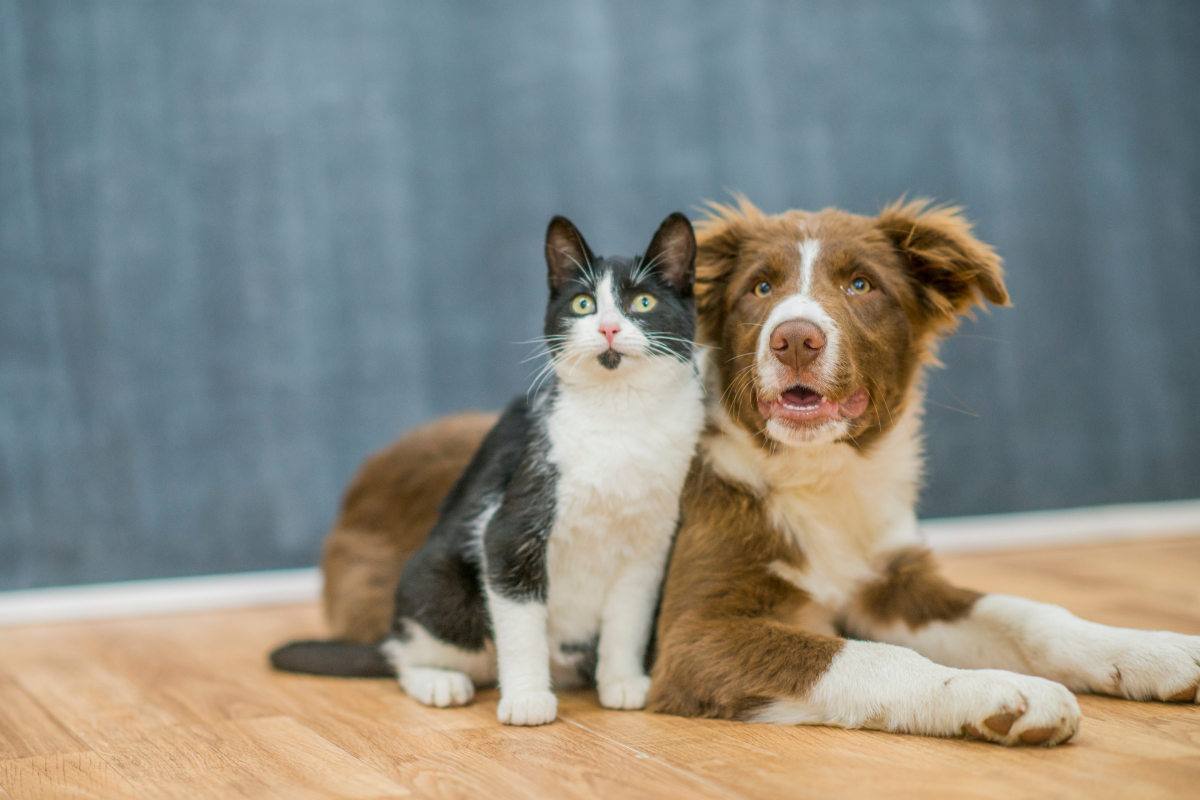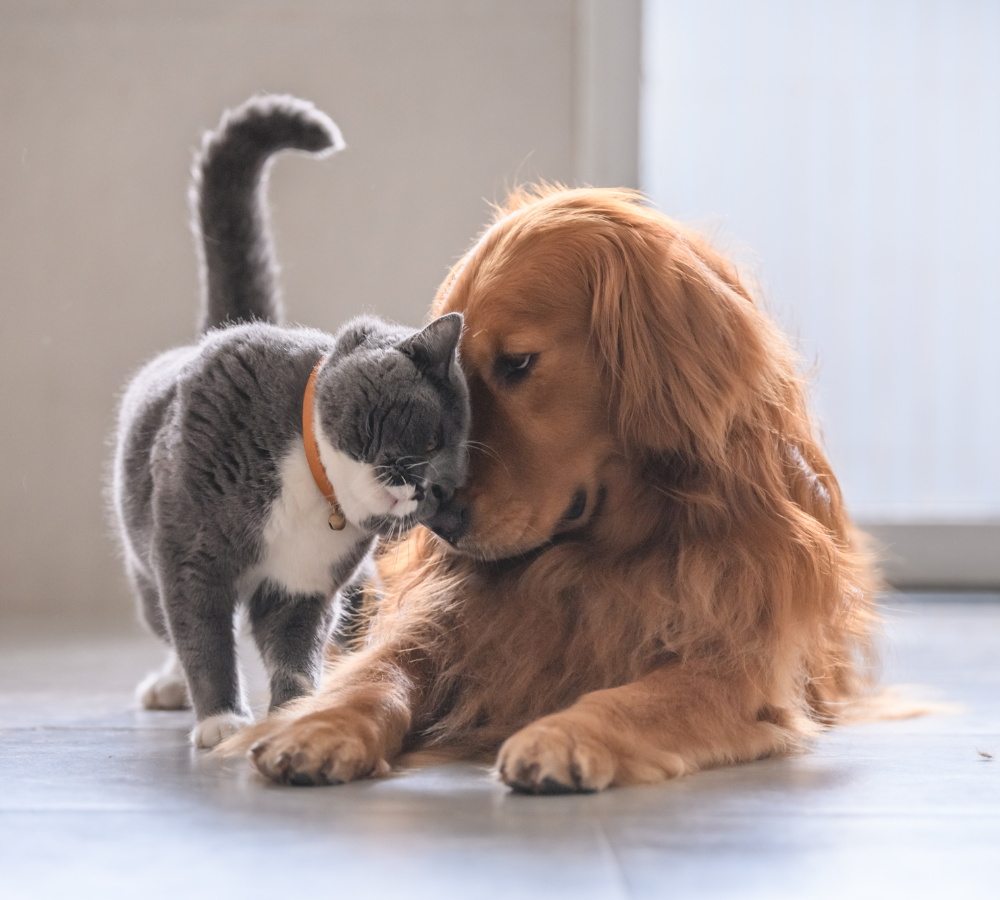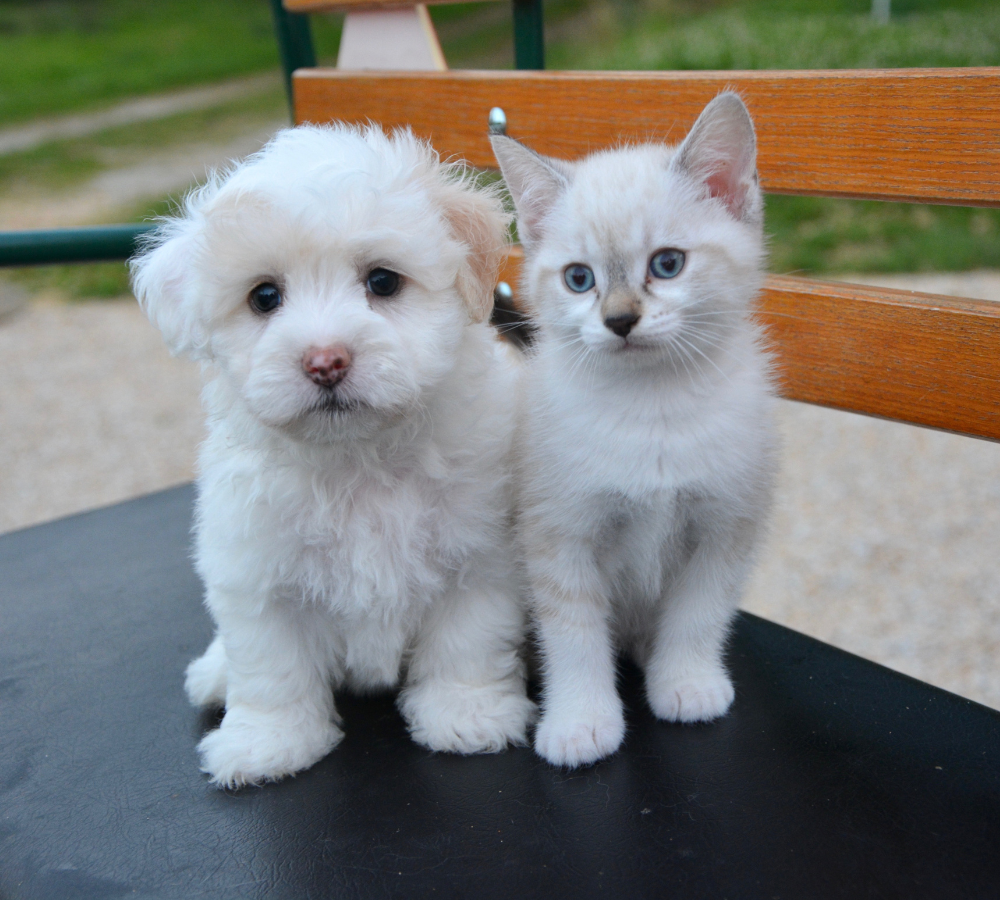Can Cats and Dogs Mate? What You Need To Know!
Can Cats and Dogs Mate? What You Need To Know!

Vet Reviewed

By: Sarah Hodgson
January 28, 2024
Table of Contents
Dogs and cats are the most popular pets on the planet. So if you happen to have a cat and dog at home and see them mounting each other it shouldn't be a shock. But can that mounting lead to mating and impregnation?
In this article, we will explore why dogs cannot mate and penetrate cats.
Let's dive in!
What Happens If a Dog and Cat Mount Each Other?
If you've ever witnessed a dog trying to mount a cat or a cat responding to such advances, you may wonder what exactly is happening.
First off, it is a common behavior so don't worry. This behavior is known as mounting and is often observed in both male and female dogs and cats. Mounting is a natural instinct for dogs, and it serves various purposes, including asserting dominance, showing territorial behavior, or even as a form of play. However, when a dog attempts to mount a cat or vice versa, it is important to understand that it is not indicative of a successful mating attempt.
In most scenarios, your dog will not try to penetrate your cat.
Can Cats and Dogs Mate?
Is it possible for cats and dogs to mate?
To put it simply, No. Cats and dogs have biological differences that make it impossible for them to mate, penetrate, or impregnate one another.
While dogs and cats can display mating-like behaviors towards each other, they are actually incapable of mating and producing offspring. The reason behind this lies in the fundamental biological differences between these two species. Cats belong to the Felidae family, while dogs are part of the Canidae family. These genetic differences make it impossible for successful reproduction to occur between them.
It's not just their genetic differences but also their anatomy and mating behaviors that make it impossible.

Can a Dog Penetrate a Cat?
So when it comes to mating we now know that they can't and it's impossible. But how about penetration?
No. While it might be physically possible for a dog to attempt to mount a cat, the anatomical differences between the two species make it virtually impossible for them to successfully penetrate one another. have a unique reproductive system that includes a penis with a specific shape and structure that is perfectly suited for mating with female dogs. Cats, on the other hand, have a completely different structure, making it impossible for a dog to successfully mate with them.
Can a Dog Impregnate a Cat?
Even if a dog and cat could physically penetrate and mate, their genetic makeup would render any attempts at impregnation futile. Dogs and cats have incompatible DNA, which means that fertilization and successful conception cannot occur.
Each species has distinct chromosomes and genetic material that cannot combine to create a viable offspring. Therefore, it is scientifically impossible for a dog to impregnate a cat or vice versa.
While there have been scientific experiments attempting to create hybrid species between different animals, including cats and dogs, these attempts have not been successful in producing real offspring.
To add to what was said earlier, such experiments raise ethical concerns and are generally not pursued due to the welfare of the animals involved.
Why Can’t Cats and Dogs Mate?
The inability of cats and dogs to mate can be attributed to several factors, including incompatible DNA, different anatomy, different mating rituals, and distinct heat cycles. We'll go over the reasons now:
Incompatible DNA
Cats and dogs have evolved separately for millions of years, resulting in significant genetic differences. These differences are responsible for the incompatible DNA, making it impossible for successful fertilization to occur.
Each species has its own unique genetic makeup, and their DNA structures are vastly different. The genetic differences between cats and dogs prevent successful fertilization and the production of viable offspring. Even if a cat and a dog were to attempt mating, the chances of conception and a successful pregnancy are close to zero.
Different Anatomy
Another reason why cats and dogs cannot mate is their distinct anatomical differences. The reproductive organs of cats and dogs are designed for mating within their respective species. While male dogs have a penis, female cats have a different reproductive structure known as a vagina.
The reproductive systems of cats and dogs are designed to be compatible only within their respective species. These differences make it physically impossible for cats and dogs to engage in successful intercourse.
Different Mating Behaviors
Cats and dogs also have different mating behaviors, which further contributes to their inability to mate. Dogs are known for their elaborate courtship behaviors, such as sniffing, licking, and nuzzling. Cats, on the other hand, have a more independent and solitary mating behaviors. The differences in their mating behaviors and preferences make it unlikely for cats and dogs to engage in successful mating.
Different Heat Cycles
Cats and dogs have different heat cycles, also known as estrus cycles, which affect their reproductive readiness. Female cats go into heat multiple times a year, typically lasting for a week or two. During this time, they become sexually receptive and seek out a male mate. Dogs, on the other hand, have less frequent heat cycles, occurring approximately every six to twelve months. The differences in their heat cycles make it difficult for cats and dogs to synchronize their reproductive cycles, further hindering their ability to mate.

Why Do Cats and Dogs Try to Mate?
While cats and dogs may not be able to mate successfully, you may have witnessed them attempting to do so. This behavior can be odd but don't worry. It has underlying reasons that are not related to reproduction.
If cats and dogs are genetically incompatible and cannot produce offspring together, why do they sometimes exhibit mating-like behaviors?
The reasons behind these behaviors can be attributed to instinct, dominance, or even playfulness.
In some cases, dogs may mount cats as a display of dominance or as a way to establish their territory. This behavior can also be seen as a form of play or even as a manifestation of sexual frustration. It is essential to understand that mounting a cat does not necessarily imply sexual intent but rather serves other purposes.
Here are the main reasons:
Sexual Frustration
Dogs that have not been spayed or neutered may experience sexual frustration and attempt to mount other animals, including cats. This behavior is driven by the natural instinct to reproduce and can be curbed through the appropriate sterilization procedures.
Dominance
Mounting can also be a way for dogs to assert dominance over other animals. By mounting a cat, a dog may be trying to establish its position in the hierarchy. This behavior is more common in untrained or poorly socialized dogs and can be addressed through proper training and socialization techniques.
Play Behavior
Dogs often engage in mounting behavior during play, especially when they are excited or overstimulated. It's important to differentiate between playful mounting and aggressive behavior. If the mounting is accompanied by growling, snarling, or other signs of aggression, it's essential to intervene and redirect the behavior.
How to Stop Mounting Behavior
Although cats and dogs cannot mate, it is not uncommon for them to exhibit mounting behavior towards each other. This behavior is often a display of dominance or playfulness rather than a sexual act. If you notice your pets engaging in mounting behavior, here are some steps you can take to manage it:
- Redirect their attention: Distract your pets with toys or treats when you observe mounting behavior. This will divert their focus and discourage the behavior.
- Provide separate spaces: Ensure that each pet has their own designated space within your home. This will help reduce any potential conflicts or dominance-related behaviors.
- Proper socialization: One way to discourage mounting behavior is through training and socialization. Providing proper obedience training and engaging in positive reinforcement techniques can help redirect your dog's attention and discourage mounting attempts
- Positive reinforcement: Reward your pets for engaging in appropriate play behaviors and discourage mounting by using positive reinforcement techniques such as treats or praise.
Note
Remember, it is essential to consult with a professional veterinarian or animal behaviorist if the mounting behavior becomes excessive or aggressive.
The Bottom Line
So there you have it, as cool as the offsprings would be dogs can't mate with cats. The genetic differences, incompatible anatomy, distinct mating rituals, and different heat cycles all contribute to the impossibility of cats and dogs mating and producing children.
So, the next time you witness such behavior, you can appreciate it for what it is—just another intriguing quirk of the animal kingdom. Thank you for reading!
Frequently Asked Questions
Can cats and dogs produce offspring?
No, cats and dogs cannot produce offspring together. They are different species with distinct genetics, making mating and reproduction between them impossible. While there are documented instances of successful mating between closely related species or different breeds within the same species, such as domestic dogs and wolves, there are no known cases of viable offspring resulting from the mating of cats.
What should I do if I encounter cats and dogs attempting to mate?
If you observe cats and dogs attempting to mate, you should intervene safely to prevent any potential harm to the animals involved. Separating the animals and providing appropriate care and supervision is recommended. Additionally, consulting with a veterinarian or animal behaviorist for guidance on managing the situation is advised.
Can spaying or neutering prevent cats and dogs from mating?
Yes, spaying (for females) and neutering (for males) are surgical procedures that remove the reproductive organs, effectively preventing cats and dogs from mating and reproducing. These procedures also offer health benefits and help control the pet population.

Subscribe to Petfluence!
Get updates on the latest posts and more from Petfluence straight to your inbox.